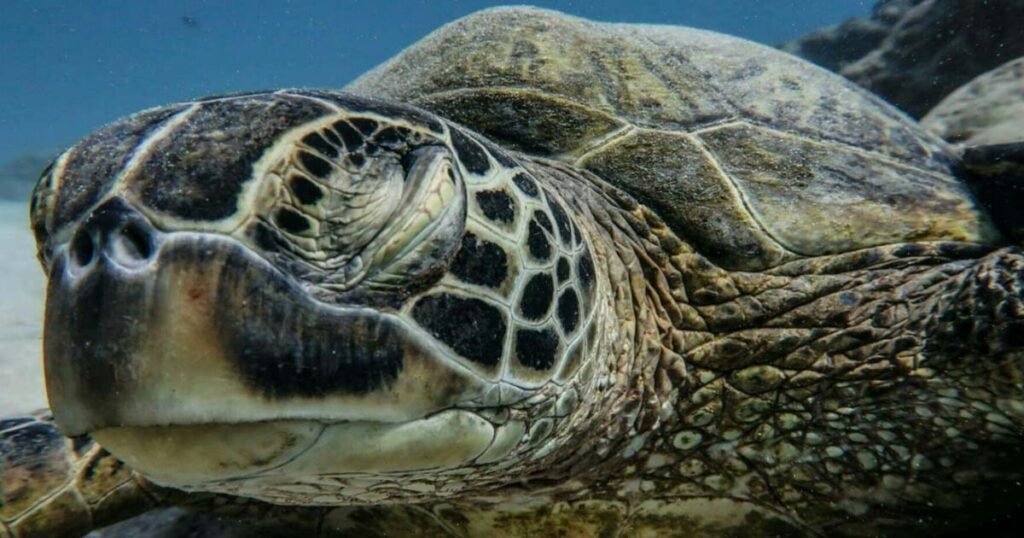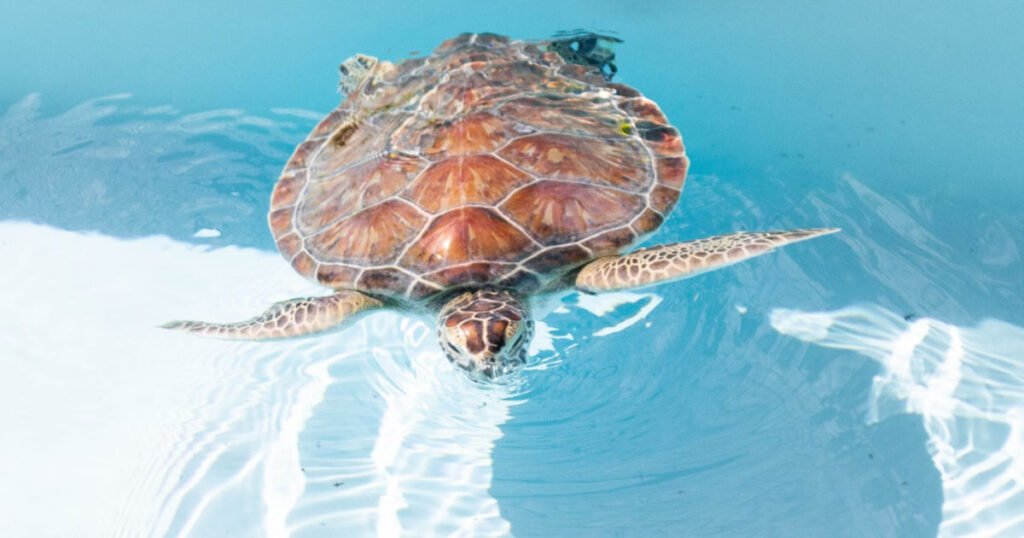Sea turtles – their name already tells us that they live in the underwater world. As they are underwater reptiles, a common question many of us have is “how do sea turtles sleep?” The sea turtle lives mostly underwater, coming up to land only to lay eggs. Like us, they need sleep for their daily routines, even though they live in the ocean. It’s fascinating to know that sea turtles can sleep underwater for extended periods, something that surprises people.
Even if sea turtles live in water, they cannot breathe underwater. They need to come up to the surface for air or oxygen intake. But when they sleep in the water, what do they do while sleeping if they need oxygen? Today, we’ll explore the fascinating sleeping habits of sea turtles and find out how they’re able to rest underwater and survive in their marine environment.
Table of Contents
Do Sea Turtles Sleep Underwater?

Yes, sea turtles actually sleep underwater, as they spend most of their time there. They sleep just like we humans do. Sea turtles, like many other marine creatures, have adapted the mechanism to sleep underwater. They find hidden spots with stable temperatures to sleep peacefully in water.
They find a safe spot like a rock, safe coral to cover which protects sea turtles from predators, as they can hide. Depending on the species, turtles’ underwater sleep duration varies due to their need for air or oxygen.
Sea turtles have sleeping routines, like us. They also sleep at consistent times and locations. This stability aids in their survival, allowing them to rest effectively while navigating ocean challenges.
How do Sea Turtles Sleep?
Sea turtles sleep uniquely due to their aquatic lifestyles. Although they can sleep underwater, they need to surface periodically to breathe. Sea turtles can stay underwater for a while, but they usually come up to breathe every few minutes.
Sleeping sea turtles often rest near the surface of the water or on the ocean floor. Some species of sea turtles have been observed to sleep while floating, with their flippers tucked in. As they rest, they may wedge themselves under rocks or coral formations to avoid drifting.
While sleeping, sea turtles cannot close their eyes since they do not have eyelids. Rather, they rely on adaptations and instincts to rest underwater, maintaining a level of awareness that allows them to surface for air when necessary.
How Long Do Sea Turtles Sleep?

Sea turtles, the champions of underwater chill, get around 4-7 hours of sleep on a regular basis. The length of their underwater naps, which can last up to 11 hours proves their aquatic abilities. It means almost half of their whole day just goes on napping time. Depending on how stressed they are, how long they snooze underwater can vary – the less stressed they are, the longer they snooze. Interestingly, sea turtles mostly sleep during day time.
How Do Sea Turtles Breath While Sleeping
The sea turtle has perfected the art of underwater sleeping, like a deep sea dreamland. Once they find a comfy nook, they turn down their metabolism, snoozing stress-free. As soon as they stop moving, their heart rate and metabolism slow down, consuming less oxygen. They rise to the surface when their oxygen levels drop, which determines the end of their underwater sleep.
While snoozing, sea turtles use half as much oxygen as they do while hunting for food, slowing their heart rate and allowing them to sleep better. Sea turtles have a natural underwater alarm clock. When oxygen levels drop, they instinctively wake up, taking a quick breath before going back to sleep. Interestingly, these ingenious creatures even generate oxygen through their rear ends while hibernating underwater during the winter months.
Underwater Sleeping Techniques of Sea Turtles

So, we know the basics of – how do sea turtles sleep underwater. Now, let’s focus on some unique techniques and the ability of sea turtles to long time breath holding technique.
Oxygen Level Control
Sea turtles regulate oxygen levels, crucial for their underwater slumber. Another surprising fact is their heart beats just once every 9 minutes, which helps them to stay underwater for long periods of time. Being cold-blooded reptiles, they adapt to the environment, slowing their heartbeat to conserve oxygen.
The Cloacal Respiration
During winter hibernation, sea turtles remain submerged for months without surfacing for air. They have evolved a special cloacal respiration technique, essentially breathing through their behinds. In this state, their reduced movement allows them to survive on minimal water oxygen intake.
Larger Lungs Advantages
Sea turtles boast larger lungs compared to other reptiles, which enables them to store more oxygen during surface breaks. This adaptation allows them to hold their breath for extended periods, vital for underwater naps.
What Is the Best Weather For Turtles Sleeping?
The temperature of a sleeping spot is crucial for turtles. They lean towards warmer spots over colder ones. Warmth helps them, as cold-blooded reptiles, stay relaxed and cozy during sleep.
They adjust their sleeping habits based on the light around them. A turtle can sleep well if it’s near the shore with sunlight bouncing off the water. As the day progresses, sea turtles often migrate to deeper waters, seeking out darker, quieter spots for deeper, more rejuvenating sleep.
Do Sea Turtles Breathe While Asleep?
No. When underwater, they hold their breath using their lungs, snoozing without needing to surface. During hibernation, they do a neat trick – breathing through their cloaca, bypassing the need to surface for air. For instance, green and black sea turtles cleverly can oxygen through their skin and cloaca as they have the ability.
How do Green Sea Turtles Sleep?
Sea turtles are often seen sleeping underwater. Particularly at night, they tend to migrate to deeper waters, which helps them sleep better. Green sea turtles choose their sleeping spots under the waves adaptably, whether they’re nestled under a rock or floating on top of the water.
This period of rest conserves energy for green sea turtles. It enables them to engage in essential activities such as mating and long-distance migrations. Additionally, it ensures they have the necessary stamina for egg-laying during the warmer months when breeding occurs.
How do Sea Turtles Sleep in the Ocean?
Sea turtles typically sleep underwater, with some species, like green sea turtles, often found resting in the ocean depths. Sea turtles sleep underwater by holding their breath for extended periods. As they rest, their oxygen consumption decreases, allowing them to stay submerged. When oxygen levels begin to drop, they naturally wake up and surface to breathe, to get their oxygen supply. This ability to regulate their breathing enables them to sleep safely in the ocean depths.
FAQ
Do sea turtles sleep at night?
Turtles are known to sleep at night, usually floating near the surface or nestling in rocky spots. However, it is said that turtles prefer daylight or warmer temperatures for sleeping. However, they sleep at night – the main reason for their sleep is quite and peaceful environment like us. Enough sleeping ensures they stay energized for their aquatic adventures.
Do Sea Turtles Sleep On Land?
Sea turtles do not sleep on land, but they do come onto land. Specifically the female turtles, to lay their eggs in the sand during the spring and summer months. All sea turtles can sleep underwater, but no sea turtle can sleep on land.
Read More: What Eats Sea Turtles: What You Need To Know
The Takeaway
To wrap it up, finding out how sea turtles sleep reveals how amazing these creatures are. The way they snooze under the waves and conserve energy give us a glimpse into their daily routines and survival techniques. The underwater antics of sea turtles never fail to fascinate us, from their serene slumber spots to their clever breathing methods.
